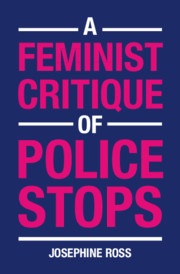Book contents
- Reviews
- A Feminist Critique of Police Stops
- A Feminist Critique of Police Stops
- Copyright page
- Dedication
- Epigraph
- Contents
- Acknowledgments
- Introduction
- Part I Bye, Bye Bill of Rights
- 1 Waive Your Rights: That’s How Stops and Frisks Were Meant to Work
- 2 The Most Dangerous Right: Walking Away from an Officer
- 3 Consenting to Searches: What We Can Learn from Feminist Critiques of Sexual Assault Laws
- 4 Punishing Disrespect: No Free Speech Allowed Here
- 5 Beyond Miranda’s Reach: How Stop-and-Frisk Undermines the Right to Silence
- Part II The Fallout
- Notes
- Index
1 - Waive Your Rights: That’s How Stops and Frisks Were Meant to Work
from Part I - Bye, Bye Bill of Rights
Published online by Cambridge University Press: 08 December 2020
- Reviews
- A Feminist Critique of Police Stops
- A Feminist Critique of Police Stops
- Copyright page
- Dedication
- Epigraph
- Contents
- Acknowledgments
- Introduction
- Part I Bye, Bye Bill of Rights
- 1 Waive Your Rights: That’s How Stops and Frisks Were Meant to Work
- 2 The Most Dangerous Right: Walking Away from an Officer
- 3 Consenting to Searches: What We Can Learn from Feminist Critiques of Sexual Assault Laws
- 4 Punishing Disrespect: No Free Speech Allowed Here
- 5 Beyond Miranda’s Reach: How Stop-and-Frisk Undermines the Right to Silence
- Part II The Fallout
- Notes
- Index
Summary
There are two theories about how stop-and-frisk prevents crime. Under the “control theory,” police employ stop-and-frisk to control neighborhoods, acting as an occupying army in order to dissuade people from carrying weapons or drugs. Made famous in New York City, these control stops violate the Constitution. The second crime-fighting theory comes directly from the Terry case where the Supreme Court imagines that a few questions can ripen into probable cause for an arrest without resort to police coercion.Implicitly, the Court in Terry envisions that some victims of unwanted stops will “voluntarily” answer questions and those answers will provide the basis to arrest and prosecute. But that’s the very justification for stop-and-frisk that crumbles when we admit that what the Court calls “voluntary” should be renamed “coerced.” In reality, civilians feel compelled to answer an officer’s questions during Terry stops, fearing arrest or other forms of retaliation, and there’s justification for such fears. A feminist view of consent undercuts Terry v. Ohio’s sole justification for stop-and-frisk. Terry v. Ohio was built on a lie.
- Type
- Chapter
- Information
- A Feminist Critique of Police Stops , pp. 21 - 38Publisher: Cambridge University PressPrint publication year: 2020

